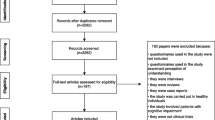Abstract
The Erice Declaration on Communicating Drug Safety Information, first published in September 1997, provides a vision of vigorous, open, ethical, patient-centred communications in drug safety that the world has yet to achieve. The Declaration is reprinted here as a further stimulus to all parties to renew their commitment and to add new momentum to the improvements which have undoubtedly taken place in the past few years. The content of the Declaration is briefly reviewed, and some of the continuing communications challenges and problems are outlined.

Similar content being viewed by others
References
McNamee D. Communicating drug-safety information. Lancet 1997; 350: 1646
Scheffler AL. Safe and effective use of medications: a global concern; Qual Saf Health Care 2002; 11: 292–3
Peart R. Procedures relating to adverse clinical incidents and outcomes in medical care. UK Parliament, evidence to the Select Committee of Health; 1999 Jun1999
Mills A, Edwards IR. The combined oral contraceptive pill: are poor communication systems responsible for loss of confidence in this contraceptive method? Hum Reprod 1999 Jan; 14(1): 7–10
Balkrishnan R, Furberg CD. Developing an optimal approach to drug safety. J Intern Med 2001 Oct; 250(4): 271–9
Edwards IR. The WHO World Alliance for Patient Safety: a new challenge or an old one neglected? Drug Saf 2005; 28(5): 379–86
The role of communication in patient safety and pharmacotherapy effectiveness. Agenda of the European Society of Clinical Pharmacy’s 35th Symposium; 2006 Oct 18-21; Vienna
Pharmacovigilance of herbal medicines: current and future directions (agenda items). Proceedings of Great Britain’s Royal Pharmaceutical Society Meeting; 2006 Apr 26–28; London
Smalley W, Shatin D, Wysowski DK, et al. Contraindicated use of cisapride: impact of food and drug administration regulatory action. JAMA 2000 Dec 20; 284(23): 3036–9
Graham DJ, Drinkard CR, Shatin D, et al. Liver enzyme monitoring in patients treated with troglitazone. JAMA 2001; 286(7): 831–3
Pirmohamed M, James S, Meakin S, et al. Adverse drug reactions as cause of admission to hospital: prospective analysis of 18 820 patients. BMJ 2004 Jul 3; 329(7456): 15–9
Improving rational drug use in Dar es Salaam, Tanzania, by elaborating and implementing Standard Treatment Guidelines (STG). Bulletin von Medicus Mundi Schweiz 1998 Marz; 68
Vedantam S. FDA told its analysts to censor data on antidepressants. Washington Post 2004 Sept 24; A08
Foggo D. ADHD advice secretly paid for by drugs companies. Daily Telegraph (UK) 2005 Oct 10
Boseley S. Drug safety body accused of cover up. Guardian (UK) 2004 Sat March 13
The Uppsala Monitoring Centre. Effective communications in pharmacovigilance; the Erice Report. Uppsala: WHO/UMC 1998
The Uppsala Monitoring Centre. Dialogue in pharmacovigilance: more effective communication. Uppsala: WHO/UMC 2002
Acknowledgements
Bruce Hugman is a consultant in communications to the Uppsala Monitoring Centre, and was one of the organising team for the 1997 Erice meeting. Professor I. Ralph Edwards and Professor Giampaolo Velo share the views expressed by Bruce Hugman in this article.
Author information
Authors and Affiliations
Additional information
PO Box 246, Amphur Muang, Chiang Rai 57000, Thailand
Appendix
Appendix
Erice is a pre-medieval town, perched on a lofty mountain at the western tip of Sicily. Its most outstanding institution is the Ettore Majorana Centre for Scientific Culture, which has 113 Schools that cover all branches of science. From time to time, this unusual academy brings together groups of distinguished scientists and thinkers from all over the world to think, talk, share their knowledge and research, and to debate future agendas and strategies in their specialty.
It was here, under the auspices of the International School of Pharmacology, that The Erice Declaration on Communicating Drug Safety Information was debated and written. In May 2002, there was a second meeting addressing the problematic issue of direct-to-consumer (DTC) advertising of drugs. This second workshop, Drug Advertising and Consumers, was organised by the Verona Reference Centre for Education and Communication within the WHO Programme for International Drug Monitoring. This reached an impasse as a result of the irreconcilable, well argued and passionately felt positions of those who wanted cautious, regulated liberalistion, and of those who were implacably opposed to any kind of DTC. The Erice Statement on Drug Advertising to the Consumer is available from URL: http://www.sfm.univr.it.
In 2006, depending on the availability of funding, it is hoped to have a third meeting with the emerging priority of patient safety and its relationship with pharmacovigilance as its topic.
Rights and permissions
About this article
Cite this article
Hugman, B. The Erice Declaration. Drug-Safety 29, 91–93 (2006). https://doi.org/10.2165/00002018-200629010-00007
Published:
Issue Date:
DOI: https://doi.org/10.2165/00002018-200629010-00007



